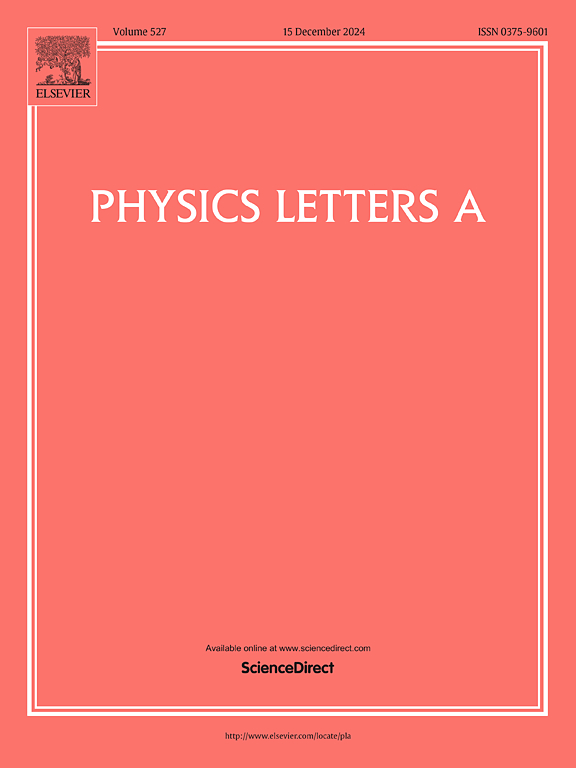光学孤子的动力学行为,以及分数手性(2+1)维NLSE的Jacobi椭圆波解
IF 2.3
3区 物理与天体物理
Q2 PHYSICS, MULTIDISCIPLINARY
引用次数: 0
摘要
各种复杂的非线性演化方程被用来说明在现实事件中发生的各种复杂过程的内在特征。在此框架下,我们利用扩展雅可比椭圆函数展开(JEFET)和扩展双曲函数技术(EHFT)分析了分数手性(2 + 1)维非线性Schrödinger方程((2 + 1)-D CNLSE)在物理和流体科学领域的光孤子解(ss)。建议的方法提供了对光孤子在各种技术领域的见解,包括量子力学,等离子体物理,非线性光学和光通信。而非线性产生失真,色散导致信号分散和恶化的距离。这些方法使我们能够产生一些光学孤子解,这些解可以用有理函数、双曲函数、三角函数和椭圆函数解析表示。双周期波(PW)、PW与块波(ss)、PW与呼吸波、各种弯曲的PW、使用扩展的JEFET的周期呼吸波,以及使用EHFT的双PW、弯曲的PW、周期呼吸波、双PW模式是得到的解的数值形式,图1至图10用三维图和二维图进行了研究。我们展示了截断的m分数参数(MFP)对二维图的影响[s = 0.1,0.5,0.9]。收集到的结果有助于澄清和更好地理解通过色散材料传播的波的物理性质。因此,前面讨论的应用技术可能是一种有用的工具,用于生产不同的、精确的ss,用于各种应用,这对工程、非线性光学和流体至关重要。本文章由计算机程序翻译,如有差异,请以英文原文为准。
Dynamical behaviors of optical solitons, and Jacobi elliptic wave solutions of fractional chiral (2+1) dimensional NLSE in physics
Various complex nonlinear evolution equations are used to illustrate the inner characteristics of various complex processes that occur in real-life events. In this framework, we use extended Jacobian elliptic function expansion (JEFET) and extended hyperbolic function techniques (EHFT) to analyze optical soliton solutions (SSs) of fractional chiral (2 + 1) dimensional nonlinear Schrödinger's equation ((2 + 1)-D CNLSE) in field of physics and in the field of fluid sciences. The suggested methods provide insights into optical soliton in a variety of technical fields, including quantum mechanics, plasma physics, nonlinear optics, and optical communications. While nonlinearity produces distortions, dispersion causes signals to disperse and deteriorate over distance. These methods allow us to produce some optical soliton solutions that may be analytically expressed in terms of rational, hyperbolic, trigonometric, and elliptic functions. Double periodic wave (PW), PW with lump wave SSs, breather wave with PW, various kinky PW, periodic breather wave by using the extended JEFET, and double PW, kink-PW, periodic breather wave, double PW patterns by using the EHFT are the numerical forms of the obtained solution that are studied with three and two-dimensional diagrams in figures 1 through 10. We demonstrate the impact of truncated M-fractional parameters (MFP) for [s = 0.1,0.5,0.9] on a two-dimensional graph. The gathered results could help to clarify and better understand the physical properties of waves traveling through a dispersive material. As a result, the previously discussed applied techniques may be a useful tool for producing distinct, accurate SSs for a variety of applications, which are essential to engineering, nonlinear optics, and fluid.
求助全文
通过发布文献求助,成功后即可免费获取论文全文。
去求助
来源期刊

Physics Letters A
物理-物理:综合
CiteScore
5.10
自引率
3.80%
发文量
493
审稿时长
30 days
期刊介绍:
Physics Letters A offers an exciting publication outlet for novel and frontier physics. It encourages the submission of new research on: condensed matter physics, theoretical physics, nonlinear science, statistical physics, mathematical and computational physics, general and cross-disciplinary physics (including foundations), atomic, molecular and cluster physics, plasma and fluid physics, optical physics, biological physics and nanoscience. No articles on High Energy and Nuclear Physics are published in Physics Letters A. The journal''s high standard and wide dissemination ensures a broad readership amongst the physics community. Rapid publication times and flexible length restrictions give Physics Letters A the edge over other journals in the field.
 求助内容:
求助内容: 应助结果提醒方式:
应助结果提醒方式:


